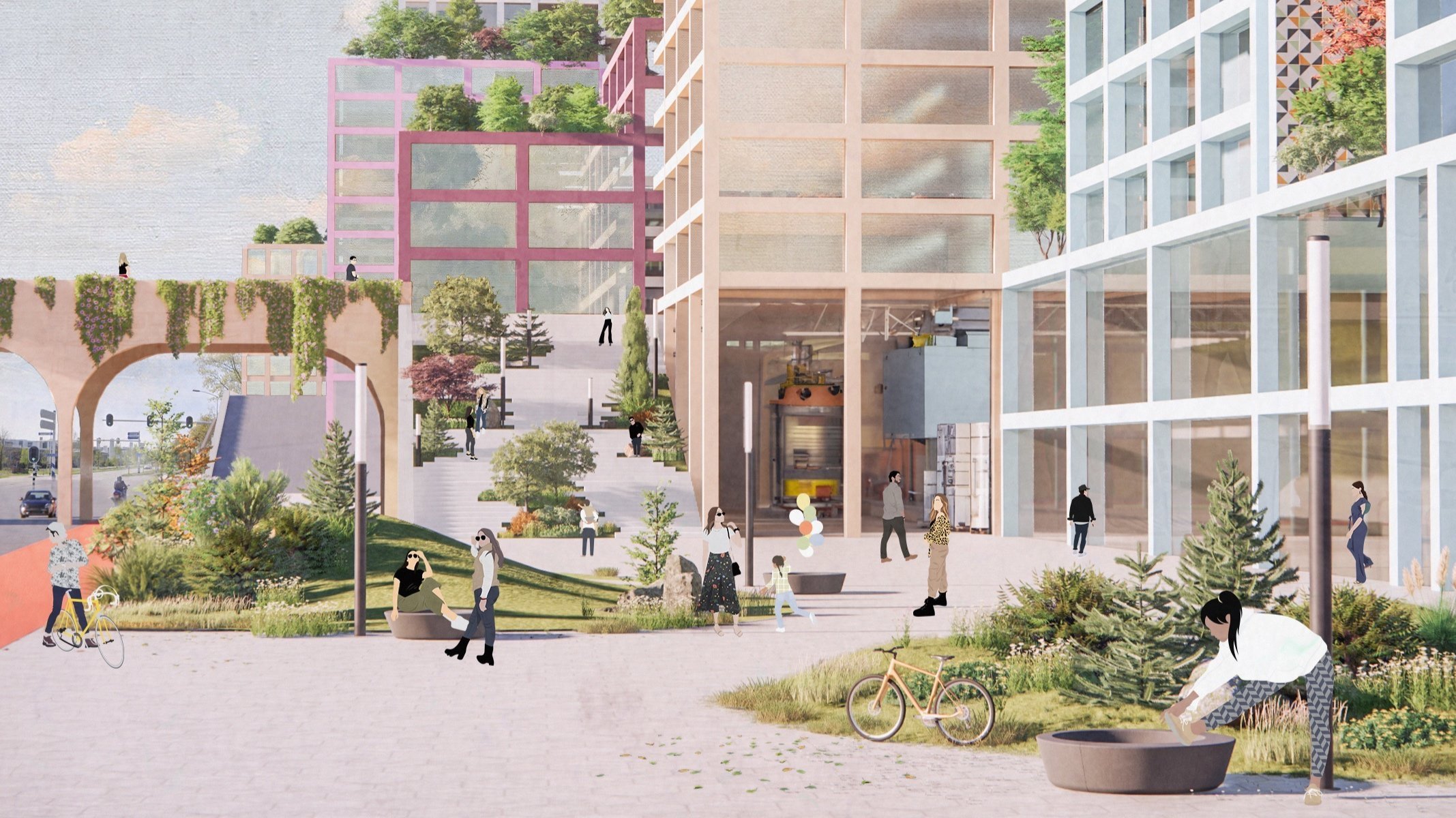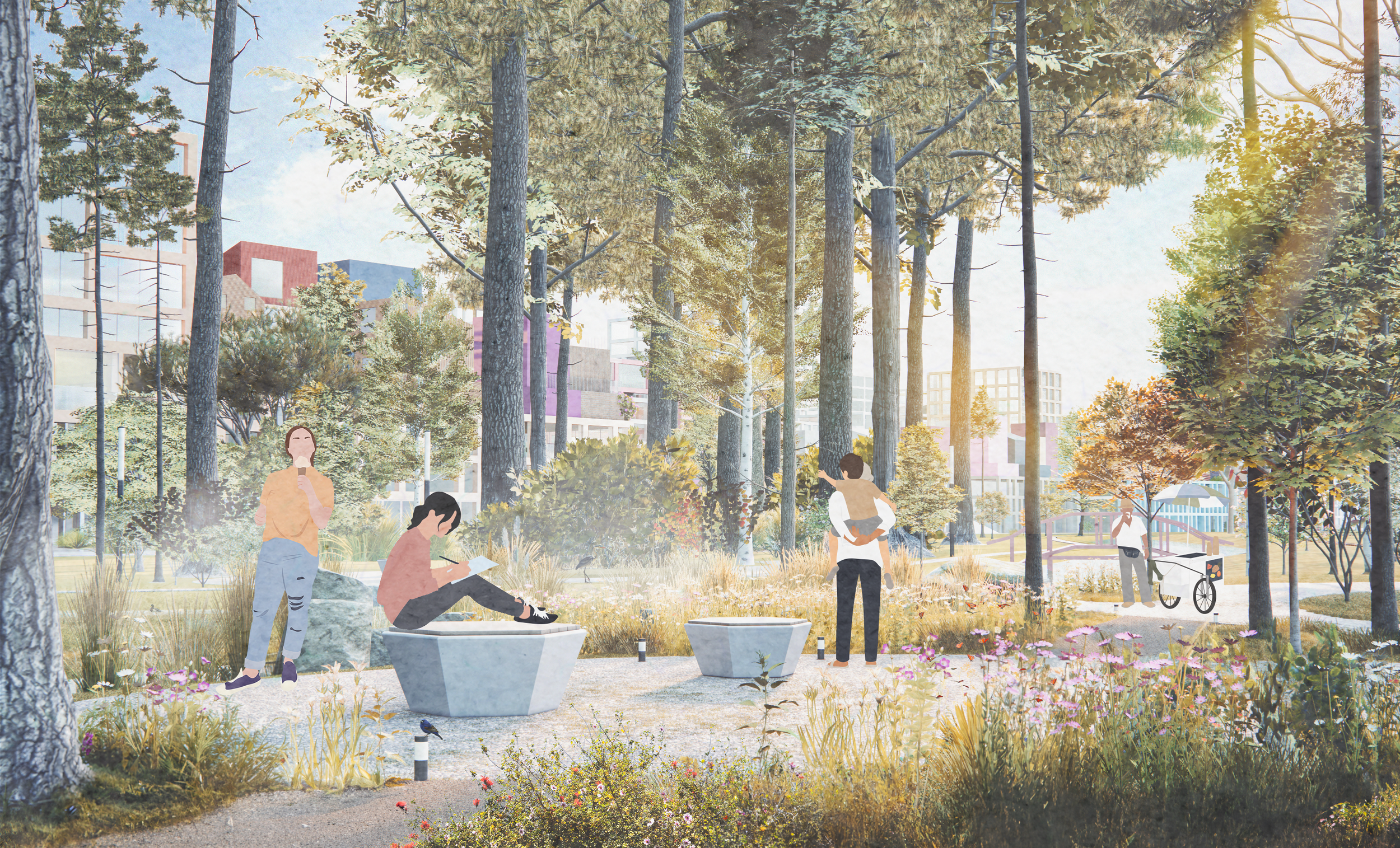SUM: Mixing Working, Living and Learning
Smart Urban Mix is revolutionizing urban life by merging working, living and learning. It addresses housing challenges, shortage of workspaces within city boundaries and the new spatial claims for climate adaptation and energy transtition.
The idea of consolidating everything in one place served as the cornerstone for our projects early on
“Our dream is to reintegrate working into residential neighbourhoods. To illustrate this dream, I often show a Medieval etching that depicts a tinsmith in a workshop. Through the window, you'd catch a glimpse of the city. In the same space, you'd also see a boy carrying something, and there's a lamp on the floor. It's a workplace right in the heart of the city, simultaneously serving as a production hub, a school, and a shop, with housing in the background. Additionally, it produces energy for lighting and such. In essence, you see everything that a healthy city should do: performing tasks where they're needed, rather than hauling goods and organizing extensive logistics, causing the unnecessary transport of people, energy and goods.”
“You see everything that a healthy city should do: performing tasks where they’re needed”
– Eric Frijters
"The idea of consolidating everything in one place served as the cornerstone for our projects early on. Through our work in Minervahaven, it became evident that not only integrating urban life into work zones yield various solutions, but also that collaboration with market players and government entities was highly productive. So two innovations emerged. One was the attempt to integrate work within the city, and the other was to do this collaboratively from the outset. Subsequently, FABRICations was invited to curate a program for Architectuurcentrum Eindhoven. I told them we'd like to conduct research and further develop the concept of working within the city, and for a year, we created programs that were essentially explorations. And that's how Smart Urban Mix came into being.”
The way we worked together was as innovative as the project itself
"We had learned from previous challenges, but we were also inspired by the location. Brainport Eindhoven is a high-tech region in the Netherlands known for its innovation, technology, and collaboration between businesses, research institutions, and government bodies. For that reason, Brainport Eindhoven is often described as a triple helix region, and we integrated that into the project as we applied for funding. It actually became a multi-helix endeavor, as our agency was actively involved and we engaged various stakeholders, including the municipalities of Veldhoven and Eindhoven, and GEVA Vastgoed, the primary landowner. This was a lesson previously learned – it's beneficial to engage directly with the landowner from the outset. Stichting Woonbedrijf contributed expertise in housing, Hogeschool Fontys conducted research and provided economic insights. Collective knowledge was incredibly productive in achieving quite revolutionary results rapidly. We had an initial idea, but it was now substantiated and embraced by various parties. It felt like the entire team had jointly conceived this solution. The way we worked together was as innovative as the project itself."
"With Smart Urban Mix, we're stacking one city on top of another, and it's surprisingly simple. We have existing industrial estates with large, spacious warehouses, often with substantial gaps in between and zones around them for parking and more. We reorganised this in a more efficient way, so we freed up room for substantial green spaces to boost the cities biodiversity and climate adaptive capacity, and added a strip of attractive features with real facades, for residential, small-scale workspaces, or amenities, turning the street into a vibrant place, creating real interactions between the public space and what happens inside the workspace. And on top, we create a residential neighbourhood. You could build this on the ground, and it would be almost like a traditional neighbourhood, but instead, we place it on the roof."
“With Smart Urban Mix, we're stacking one city on top of another – and it's surprisingly simple”
– Eric Frijters
"Consolidating all workspaces and even building on the roof results in several benefits. First, significant space savings. Second, numerous sustainability advantages – compactness, reduced energy consumption, etcetera. But there is another significant advantage, as we encountered a small stream located opposite ASML. We wondered about its significance. Given our involvement with a swarm of experts, including specialists in water-related challenges, we learned that this river is crucial for climate adaptation and the future water challenges facing the entire region. If we wouldn't address this, the entire city would face problems. Therefore, by efficiently managing space, we freed up a substantial area for green spaces, creating a large park through which the waterway flows, significantly enhancing the area's resilience."
"When applying Smart Urban Mix, sustainability measures are immediately visible across various scales, which confirmed our initial hypothesis. The Netherlands faces a shortage of housing, but what everyone tends to overlook is the shortage of business spaces, and in addition we have sustainability challenges that need to be addressed, and these challenges also consume space. We have three space demands within the same region, and Smart Urban Mix is in fact a solution to tackle all three simultaneously. We have demonstrated that by involving experts, you can navigate this intelligently and mitigate objections early on.”
We cleared the path for everyone and made it easier to proceed with this project
“We are aware that we're proposing a city that has never been built before. But by inviting all stakeholders to engage immediately and organizing extensive workshops, we cleared the path for everyone and made it easier to proceed with this project, which turned out quite successful. Of course, there are challenges, but we've always found the way to solutions, even addressing financing and affordability. We acknowledge that we need to do things differently, impose different requirements, but that's how we can make it happen."
“Based on this project and the research we've conducted, I see that mixing living and working is entirely feasible. Perhaps not exactly in the way we've done it, but consolidating these functions is possible because it offers real advantages. You can see from the visualizations that it looks truly appealing. You wouldn't even recognize it as a traditional industrial estate, so it's an intriguing solution.”
During Dutch Design Week, from the 21st until the 29th of October 2023, the exhibition 'Smart Urban Mix in the Brainport Region' will be on display at Natlab. On Wednesday the 25th of October, we will take a moment with several stakeholders to reflect on the research project. We'll discuss the key findings, insights, and the project's future direction. Eric Frijters will be joined by Cees-Jan Pen (lecturer in 'entrepreneurial regions' at Hogeschool Fontys), Aya Bergkamp (social designer at Future Mentors Eindhoven), and Angelique Bellemakers (urban envoy for 'Breakthrough Neighborhood-Centered Work' at the Municipality of Eindhoven).




